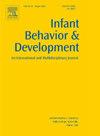Contextual differences in parent-child interactions: A study on toddlers at elevated likelihood of autism and their mothers
IF 1.9
3区 心理学
Q3 PSYCHOLOGY, DEVELOPMENTAL
引用次数: 0
Abstract
Parent-child interactions are important for children’s emotional and behavioral development. In autism research, parent-child interactions are typically observed during free play. Yet, studies outside the autism field underscored the importance of observing parent-child interactions during other contexts, as parents’ behaviors may depend on the context, and different contexts may reveal different relationships between parents’ and children’s behaviors. Therefore, we observed interactions between 102 mothers and their 24-month-old children at elevated likelihood of autism during two scenarios: free play and goal-directed play. Participating children had an older autistic sibling (n = 68) or were born very preterm (born before 30 weeks; n = 34). We found that mothers adapt their behaviors to contextual cues, which supports and expands on previous findings regarding older autistic children, and children without autism. Furthermore, as expected, the relationship between mothers’ and children’s outings of negative affect only became apparent during the goal-directed play scenario. A relationship between mothers’ and children’s outings of positive affect was found in both scenarios, thus regardless of the context. Parent-reported emotional and behavioral difficulties of children were not related to maternal behaviors during either context, nor to fluctuations in maternal behaviors across contexts. This contrasts with studies with older children, which did find such relationships. Therefore, our findings suggest that predictable patterns might not yet be visible when children’s emotional and behavioral difficulties first become apparent.
亲子互动中的情境差异:对自闭症高可能性幼儿及其母亲的研究。
亲子互动对儿童的情感和行为发展非常重要。在自闭症研究中,亲子互动通常是在自由玩耍时观察到的。然而,自闭症领域之外的研究强调了在其他情境下观察亲子互动的重要性,因为父母的行为可能取决于情境,而不同的情境可能揭示出父母与孩子行为之间的不同关系。因此,我们观察了102位母亲和她们24个月大的孩子在两种情况下的互动:自由游戏和目标导向游戏。参与研究的儿童有年龄较大的自闭症兄弟姐妹(n = 68)或早产(出生在30周前;n = 34)。我们发现,母亲会根据情境线索调整自己的行为,这支持并扩展了之前关于年龄较大的自闭症儿童和非自闭症儿童的研究结果。此外,正如预期的那样,母亲和孩子的消极情绪之间的关系仅在目标导向的游戏场景中变得明显。在这两种情况下,母亲和孩子的积极情感表现之间都存在关系,因此与环境无关。父母报告的儿童的情绪和行为困难与母亲在这两种情况下的行为无关,也与母亲在不同情况下的行为波动无关。这与对年龄较大的儿童的研究形成对比,后者确实发现了这种关系。因此,我们的研究结果表明,当儿童的情绪和行为困难第一次变得明显时,可预测的模式可能还不明显。
本文章由计算机程序翻译,如有差异,请以英文原文为准。
求助全文
约1分钟内获得全文
求助全文
来源期刊

Infant Behavior & Development
PSYCHOLOGY, DEVELOPMENTAL-
CiteScore
4.10
自引率
4.80%
发文量
94
期刊介绍:
Infant Behavior & Development publishes empirical (fundamental and clinical), theoretical, methodological and review papers. Brief reports dealing with behavioral development during infancy (up to 3 years) will also be considered. Papers of an inter- and multidisciplinary nature, for example neuroscience, non-linear dynamics and modelling approaches, are particularly encouraged. Areas covered by the journal include cognitive development, emotional development, perception, perception-action coupling, motor development and socialisation.
 求助内容:
求助内容: 应助结果提醒方式:
应助结果提醒方式:


